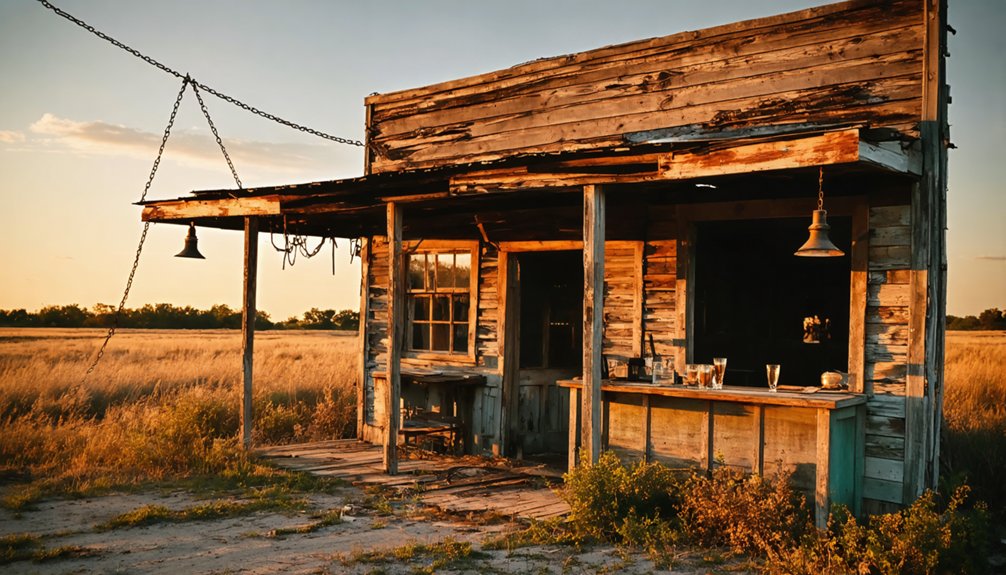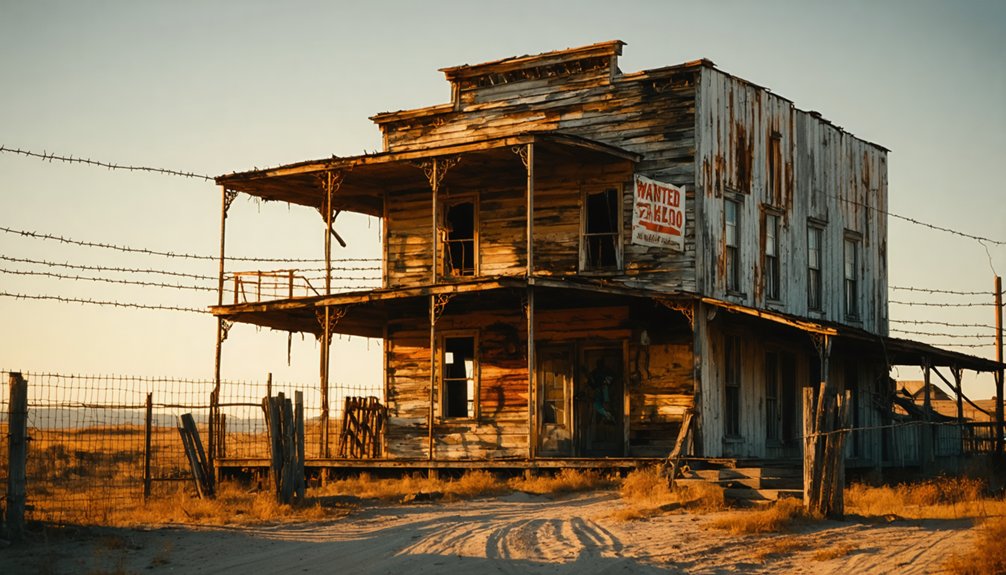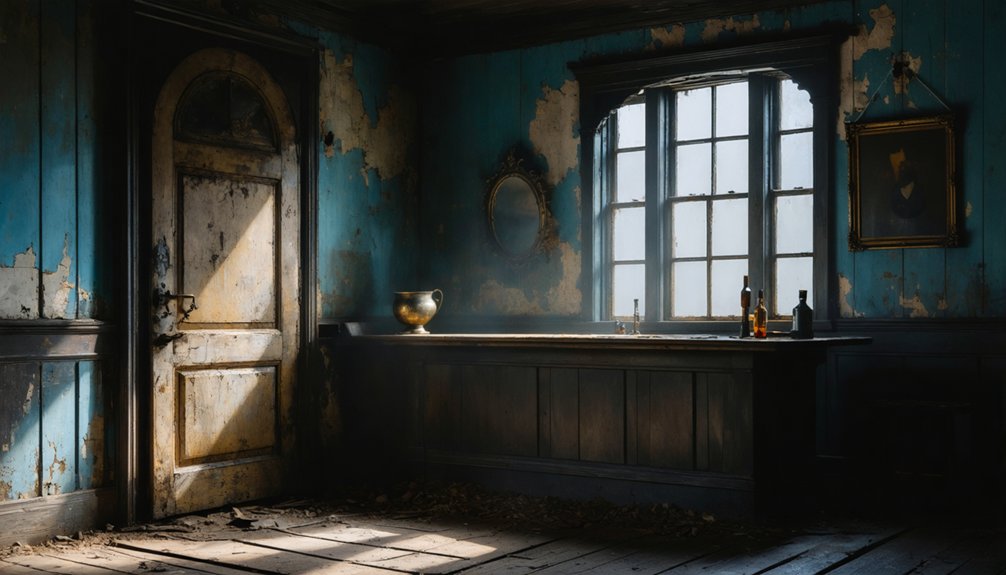Texas harbors over 900 ghost towns, each telling unique stories of boom-and-bust cycles. You’ll find mercury mining ruins in Terlingua, abandoned Route 66 landmarks in Glenrio, and crumbling educational aspirations in Belle Plain. These settlements showcase nature’s reclamation of human endeavors, with concrete mills consumed by forests in Aldridge and sacred Comanche sites in Medicine Mound. The cemeteries and architectural remains offer windows into frontier life’s harsh realities and fleeting prosperity.
Key Takeaways
- Terlingua features mercury mining ruins, a historic cemetery, and the remnants of Howard Perry’s mansion dating back to its 1,000-resident heyday.
- Glenrio’s abandoned Route 66 landmarks include the State Line Motel and Little Juarez Diner, casualties of Interstate 40’s 1975 bypass.
- Belle Plain contains ruins of an ambitious college whose music department once boasted twelve grand pianos before declining after 1892.
- Aldridge’s concrete sawmill ruins show nature’s reclamation, with massive trees growing through foundations of this once-thriving industrial boomtown.
- Medicine Mound preserves two stone buildings beneath sacred Comanche hills, with one housing a museum documenting the town’s pre-Depression prosperity.
Terlingua: Mercury Mining Ruins in the Desert Landscape

Nestled along the arid banks of Terlingua Creek, the ghost town of Terlingua stands as a hauntingly preserved relic to Texas’s mercury mining era.
You’ll witness the remnants of what was once a thriving community of over 1,000 residents, built around the lucrative cinnabar extraction industry that flourished until the mid-1940s.
As you explore, you’ll encounter Howard Perry’s mining mansion, decaying mine shafts, and the weathered St. Agnes Church from 1913.
The Terlingua Cemetery, listed on the National Register of Historic Places, tells silent stories of miners who once toiled in this unforgiving terrain.
The landscape preservation here is remarkable—the Chisos Mining Company’s abandoned structures stand as evidence to boom-and-bust economics that shaped the West, allowing you to walk freely through authentic pieces of industrial history. Today, visitors can experience the town’s revival through the famous Chili Cookoff that helped bring Terlingua back to life. During the peak years, the company generated approximately 12 million dollars from mercury sales before operations ceased.
Glenrio: A Forgotten Route 66 Landmark on the Texas Border
Straddling the Texas-New Mexico border, Glenrio stands as a haunting reminder of how Interstate 40’s 1975 bypass severed the town’s commercial lifeline.
You’ll find the abandoned State Line Motel, Little Juarez Diner, and Texaco station among seventeen deteriorating structures that compose the Glenrio Historic District, listed on the National Register of Historic Places in 2007.
The town’s remaining concrete foundations and stucco walls chronicle its transformation from a thriving Route 66 stopover, where unique cross-border regulations once dictated that bars operated only on the New Mexico side while gas stations flourished exclusively in Texas. Originally established in 1905 when the Chicago, Rock Island and Gulf Railway extended through the area, Glenrio once boasted a peak population of 84 residents. Today, visitors can stop at the Visitor Center operated by the New Mexico Department of Transportation for travel information and historical context about this fascinating ghost town.
Interstate 40’s Fatal Bypass
When Interstate 40 sliced through the Texas Panhandle in 1973, it effectively signed Glenrio’s death warrant. This transportation legacy permanently altered the town’s trajectory, as the new highway deliberately bypassed the once-thriving Route 66 stop.
You can trace Glenrio’s urban decay directly to this infrastructure decision, which diverted all through traffic away from local businesses.
The interstate’s completion coincided with Route 66’s official decommissioning in Texas, creating a perfect storm of abandonment. With no rail service since 1955 and now stripped of highway travelers, Glenrio’s population plummeted from thirty to merely five by 2000.
Before its decline, Glenrio featured a vibrant mix of contrasting state laws that created unique business opportunities on either side of the Texas-New Mexico border.
The post office shuttered in the 1980s, and by the 21st century, no permanent residents remained. What stands today is merely the skeletal remains of a community sacrificed for modern transportation efficiency. Visitors interested in Route 66 history can still explore the abandoned structures including the iconic Little Juarez Cafe that once served weary travelers.
Remnants of Route Glory
Standing as a haunting monument to America’s automotive past, Glenrio tells a story beyond mere highway abandonment. This once-thriving Route 66 outpost now offers ghostly remnants of mid-century roadside architecture, preserved in the tension between Texas and New Mexico regulations.
The Glenrio Historic District’s 17 abandoned structures earned National Register status in 2007.
Economic constraints created unique business patterns—dry Texas prohibited bars while New Mexico’s higher gas taxes prevented service stations.
Post-WWII prosperity transformed the former dirt track into a cultural icon and vacation corridor.
The Little Juarez Diner, State Line Bar, and State Line Motel stand as symbols of route nostalgia.
When I-40 bypassed Glenrio in 1975, it severed the town’s commercial lifeline, accelerating its abandonment.
Belle Plain: The College Town That Time Forgot
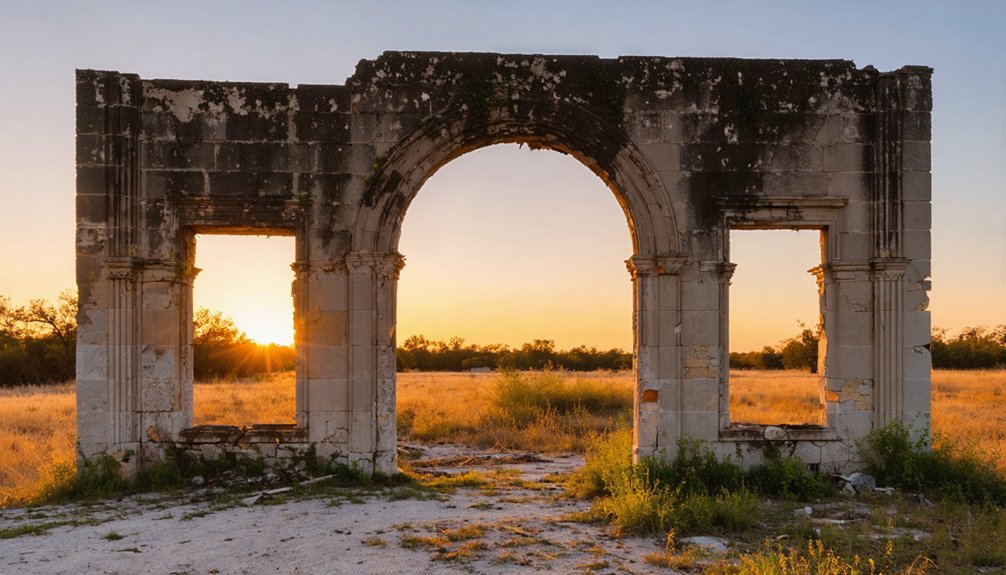
You’ll find Belle Plain College’s ruins standing as a symbol to West Texas’s ambitious educational aspirations, with its stone buildings eerily persisting despite the town’s catastrophic population collapse.
The college’s music department, once home to twelve grand pianos, represents the cultural sophistication that briefly flourished before drought and railway developments decimated the settlement. These remnants are located on private property, with strict prohibitions against trespassing enforced by the landowners.
When visiting the cemetery, you’re likely to encounter local tales of paranormal activity surrounding these hollowed structures, where only four families remained by 1897 following the college’s closure in 1892. The town’s decline was accelerated when the railroad company made the pivotal decision to bypass Belle Plain in favor of nearby Baird.
Lost Educational Dreams
Among Texas’s forgotten settlements, Belle Plain stands as a poignant tribute to ambitious educational aspirations that withered on the frontier. Belle Plain College, established in 1881 by Methodist pioneers, represented the community’s commitment to intellectual freedom and cultural advancement despite harsh frontier conditions.
The college’s tragic trajectory mirrors the town’s cultural decline:
- Founded with 10 donated acres and substantial local financial backing
- Boasted 15 pianos, a brass band, and orchestra—remarkable for a frontier institution
- Expanded to 122 students under Rev. J.T.L. Annis’s leadership
- Operated from imposing stone structures with a distinctive fourth-story cupola
- Continued operations even after mortgage foreclosure until 1892
The town’s prosperity peaked in the late 1870s with nearly a thousand inhabitants before railroads bypassed the settlement. The institution experienced frequent leadership changes that contributed to its instability throughout its brief existence.
When you visit today, only windowless ruins remain—silent sentinels to educational dreams crushed by railroad politics, environmental hardship, and financial collapse.
Cemetery Tells Tales
The weathered headstones of Belle Plain Cemetery remain the most eloquent witnesses to this frontier town’s spectacular rise and fall. Dating back to the settlement’s 1876 founding, these limestone markers chronicle the brief flowering of a once-promising college town.
Walking among these graves today, you’ll find yourself immersed in the archaeological record of frontier ambition. Cemetery legends abound – particularly regarding the college’s abandoned buildings where visitors report ghostly encounters after sunset. Local paranormal researchers have documented unexplained light phenomena and spectral apparitions near the crumbling dean’s residence.
The cemetery’s meticulous chronology reveals Belle Plain’s demographic collapse – burials becoming increasingly sparse after 1883 when Baird claimed the county seat. This necropolis serves as the final repository of community memory, preserving what railroad politics and drought ultimately destroyed.
Aldridge: Nature Reclaiming a Sawmill Boomtown
Deep in the pine forests of East Texas, Aldridge stands as a tribute to the boom-and-bust cycle that defined many early industrial communities. Founded in 1898, this sawmill boomtown’s haunted histories and forgotten futures are etched into the crumbling concrete walls of its once-thriving mill.
You’ll encounter remarkable evidence of nature’s reclamation:
- Concrete mill ruins standing defiant against time
- Massive trees growing directly through foundations
- Stone structures forming ghostly labyrinths near the mill pond
- Railroad beds where tracks were pulled up in 1927
- Graffiti-covered walls hinting at subsequent human intrusions
The town’s dramatic demise followed devastating fires and timber depletion. By the mid-1920s, all residents had abandoned their homes.
Now preserved on the National Register of Historic Places, Aldridge offers a profound glimpse into industrial ambition overwhelmed by nature’s persistence.
Carlton: The Semi-Ghost Town of Central Texas

Nestled in Hamilton County’s northeastern corner, Carlton presents a compelling case study in rural decline and resilience. Established in 1877 by Dr. F.M. Carlton and J.M. Evans, this settlement at the crossroads of FM Roads 219 and 1744 exemplifies boom-and-bust patterns characteristic of Texas Hill Country communities.
Carlton’s ghost town history reveals dramatic demographic fluctuations—from 750 residents in 1910 to merely 70 by 2000. The abandoned cotton gin, post office, and deteriorating main street structures constitute tangible evidence of economic transformations that reshaped rural Texas throughout the 20th century.
Carlton’s significance extends beyond its semi-abandoned status. You’ll find this unincorporated community preserves an authentic tableau of Texas rural life, where abandoned buildings stand as silent witnesses to shifting economic fortunes, offering you unfiltered access to a crystallized moment in western settlement history.
Medicine Mound: Sacred Hills and Abandoned Storefronts
You’ll find Medicine Mound‘s haunting remnants nestled beneath four sacred conical hills that once served as spiritual refuge for Comanche tribes before white settlers arrived in the early 1900s.
The town’s meteoric rise to commercial prosperity ended abruptly with the 1929 economic collapse, followed by the catastrophic 1933 fire that consumed nearly every wooden structure when Ella Tidmore reportedly set a barber shop ablaze at 3 a.m.
Today, only two stone buildings remain standing, with one repurposed as the Downtown Medicine Mound Museum chronicling the agricultural community’s brief but significant history.
Sacred Comanche Significance
Rising dramatically from the surrounding plains, the four dolomite formations known as Medicine Mounds served as the spiritual epicenter for the Comanche Nation, transcending their geological prominence to embody profound cultural significance.
These natural “sky islands” provided the foundation for Comanche spirituality through ritualistic practices and sacred connections.
When you visit these sacred mounds, consider their historical importance:
- Warriors conducted vision quests after days of fasting to receive spiritual guidance
- Medicine Mound and Cedar Mound were designated as particularly sacred sites
- Redberry cedar and other medicinal plants thrived exclusively on these formations
- Healing springs at the base provided mineral waters for remedies
- Esteemed tribal members were buried here, making the ground hallowed
The mounds remain powerful symbols of indigenous wisdom and spiritual freedom that transcended colonial boundaries.
Depression-Era Economic Collapse
The economic devastation of the Great Depression struck Medicine Mound with particular ferocity, transforming a once-thriving settlement into a hollow shell of its former prosperity. By 1940, the population had plummeted from 500 to merely 210 residents as economic hardship forced families to abandon their homes.
A catastrophic fire in 1932 decimated the town’s business district during the Depression’s darkest days, with reconstruction virtually impossible amid financial constraints.
The agricultural decline proved equally devastating—cotton and grain prices collapsed while drought parched the land, rendering farming unprofitable. When the Kansas City, Mexico and Orient Railway ceased operations through Medicine Mound, the final economic lifeline was severed.
You can still witness the skeletal remains of this community that succumbed to forces beyond its control, a haunting reminder to rural America’s vulnerability.
Repurposed History Museum
Among Medicine Mound’s crumbling remnants, four cobblestone structures have found new purpose as the Downtown Medicine Mound Museum, a tribute to both preservation and memory.
You’ll discover a meticulously curated collection of repurposed artifacts that chronicle the area’s evolution from Comanche spiritual center to frontier settlement.
- Original general store displays showcase pioneer commerce and agricultural implements
- Photographic archives document the distinctive cobblestone architecture following the 1930s fire
- Comanche ceremonial items represent the sacred connection to the nearby mounds
- Family heirlooms from descendants of original settlers provide intimate glimpses of daily life
- Interactive exhibits foster community engagement through rotating local historical collections
The museum operates as both guardian of Medicine Mound’s complex past and catalyst for cultural dialogue, inviting you to witness how abandonment transformed into purposeful historical stewardship.
The Stories Behind Texas Ghost Town Cemeteries
Four forgotten Texas ghost town cemeteries—Terlingua, Camptown, Springfield, and Chalk Mountain—offer haunting glimpses into the state’s complex past.
These burial grounds chronicle the rise and fall of communities shaped by economic forces, racial dynamics, and industrial decline.
Terlingua Cemetery, with its 400 largely Hispanic graves, narrates the mercury mining town’s boom-and-bust cycle, while Camptown emerged as a cultural landmark where Freedmen established their identity after slavery.
Springfield Cemetery witnessed the town’s abandonment after the railroad bypassed it, leaving a predominantly African-American community behind.
The cemetery significance extends beyond historical preservation—these sites document occupational hazards, epidemics, and childhood mortality rates.
From miners killed in collapses to victims of influenza, each headstone represents a thread in the tapestry of Texas’s frontier experience.
Photographing Texas Ghost Towns: Best Times and Locations
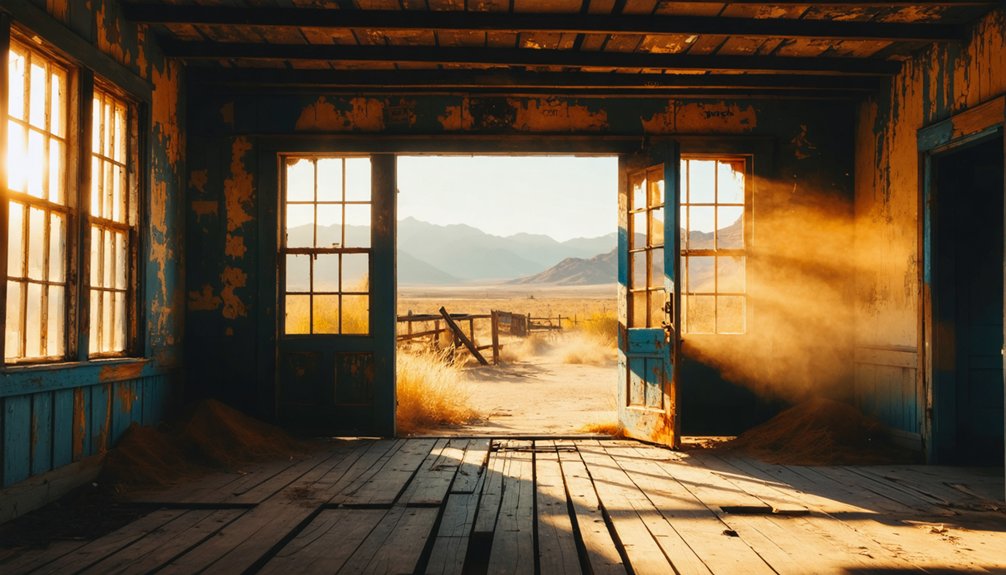
Capturing the haunting beauty of Texas ghost towns requires careful timing and location selection to achieve ideal photographic results. The quality of ghost town lighting greatly impacts your visual narrative, with early morning and late afternoon offering the most atmospheric conditions for authentic documentation.
The ethereal charm of abandoned settlements emerges through strategic timing and the golden glow of dawn and dusk.
- Terlingua provides exceptional opportunities with its well-preserved ruins against the dramatic Big Bend landscape.
- Winter months (December-February) deliver clearer skies and reduced harsh contrast issues.
- Wide-angle lenses prove essential for contextualizing isolated structures within their vast surroundings.
- Polarizing filters considerably enhance texture details and deepen sky tones, particularly in desert locations.
- Medicine Mound’s remaining general store and vintage gas pumps offer compelling compositional elements for photography tips implementation.
When traversing these remote treasures, you’ll need to account for unpredictable weather patterns and limited access to power—challenges that ultimately contribute to the raw authenticity of your images.
Weekend Road Trip: Exploring Multiple Ghost Towns in One Journey
Texas offers a wealth of ghost town exploration opportunities that can be efficiently combined into a single weekend road trip, allowing history enthusiasts to maximize their abandoned settlement experiences.
The ideal circuit encompasses five distinct sites: begin in Terlingua near Big Bend, then traverse northward to art-centric Marfa via US-90, followed by the oil boom relics of Lobo and Orla along I-10, concluding at Route 66’s Glenrio at the New Mexico border.
Each location presents distinct analytical frameworks for interpreting ghost town history.
You’ll need methodical preparation: fuel strategically, download offline maps, and carry provisions. The journey covers approximately 1,100 miles with 20 hours of driving time.
Spring and fall offer ideal conditions for these weekend adventures, when you can photograph structures without extreme temperatures compromising your documentary expedition.
Preserving History: Conservation Efforts in Texas Ghost Towns
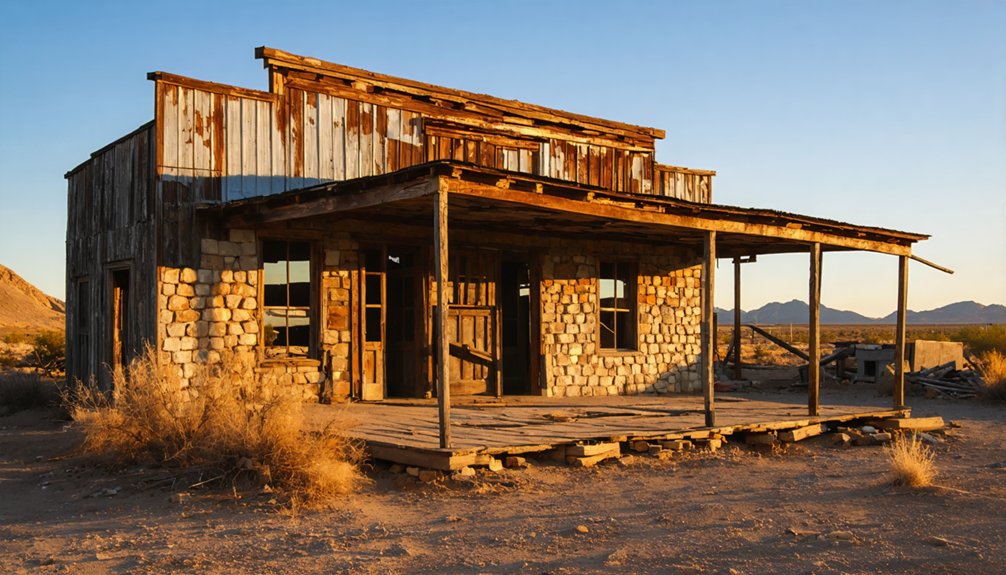
While abandoned for decades, Texas ghost towns now face a complex web of preservation challenges that demand systematic conservation approaches from multiple stakeholders.
Conservation initiatives combine structural restoration with community engagement strategies to guarantee historical integrity while revitalizing these forgotten settlements.
Key preservation strategies include:
- Documenting oral histories and engaging communities through historical events
- Adapting dilapidated structures through strategic rehabilitation or stabilization
- Negotiating complex ownership landscapes across multiple parcels
- Resolving infrastructure deficiencies while respecting historical authenticity
- Balancing modern amenities with preservation of ghostly atmosphere
Towns like Terlingua and Lobo demonstrate successful adaptive reuse methodologies, transforming mining infrastructure into visitor accommodations and artist havens.
These approaches honor historical significance while creating sustainable futures for these settlements, allowing you to experience authentic connections to Texas’s frontier past.
Frequently Asked Questions
Are These Ghost Towns Legally Accessible to the Public?
Over 70% of Texas ghost towns have mixed public access status. You’ll need to verify legal restrictions for each site—some allow visitation via public roads while others require owner permission.
What Supernatural Legends Are Associated With These Abandoned Towns?
You’ll encounter ghostly sightings at Terlingua’s mercury mines, Shackelford’s guardian spirits protecting gold, Ben Ficklin’s phantom flood victims, and Medicine Mound’s indigenous floating lights—each haunted relic preserves distinct supernatural narratives worth investigating firsthand.
Can Visitors Take Artifacts or Souvenirs From These Sites?
Like walking off with Pompeii’s treasures, you shouldn’t take artifacts from these sites. Artifact preservation demands ethical considerations—it’s often illegal, damages historical context, and violates private property rights. Respect freedom through responsible stewardship.
How Dangerous Are Structural Hazards in These Ghost Towns?
Structural hazards pose extreme dangers with deteriorated buildings lacking structural integrity. You’ll encounter crumbling masonry, rotted wood, and unstable foundations. Always prioritize safety precautions during your explorations through these precarious spaces.
Do Any Former Residents Still Return for Reunions?
You’ll find ghost town reunions are rare and informal. Former resident stories persist mainly through cemetery visits, Terlingua’s annual Chili Cookoff, and scattered family pilgrimages to ancestral homesteads across Texas’s abandoned settlements.
References
- https://www.youtube.com/watch?v=Zd8-gKw-5Hc
- https://livefromthesouthside.com/10-texas-ghost-towns-to-visit/
- https://www.hipcamp.com/journal/camping/texas-ghost-towns/
- https://tpwmagazine.com/archive/2018/jan/wanderlist_ghosttowns/
- https://mix931fm.com/texas-ghost-towns-history/
- https://www.tripadvisor.com/Attractions-g28964-Activities-c47-t14-Texas.html
- https://www.texasescapes.com/TOWNS/Texas_ghost_towns.htm
- https://authentictexas.com/texas-ghost-towns/
- https://content.govdelivery.com/accounts/TXPWD/bulletins/1dcdee4
- https://www.legendsofamerica.com/tx-terlingua/

